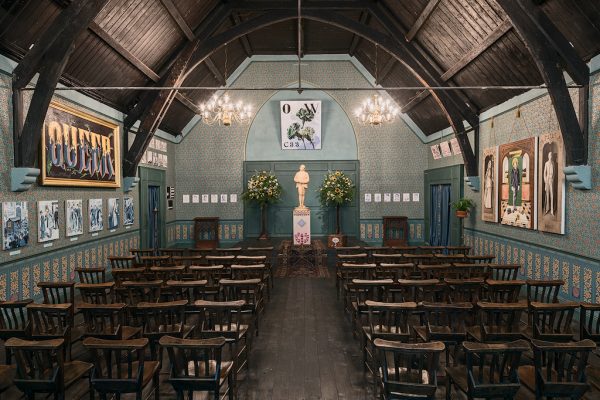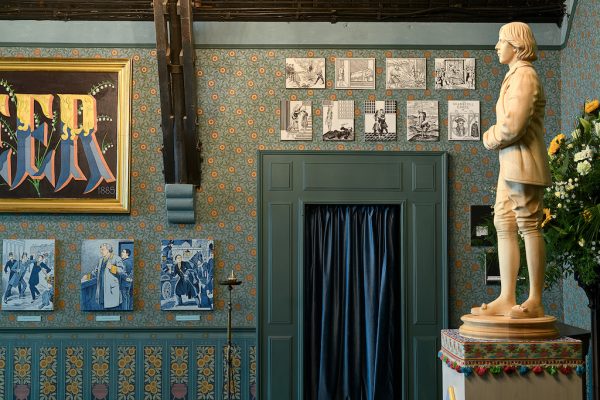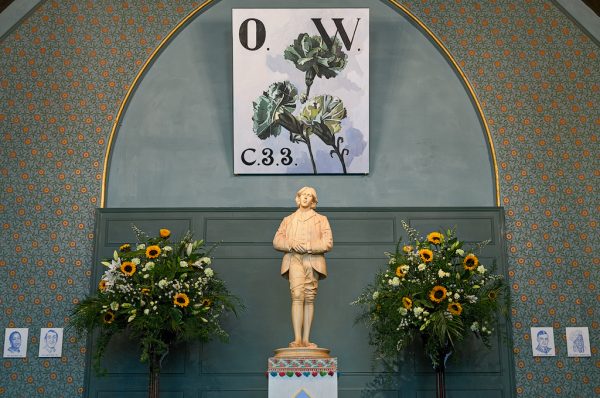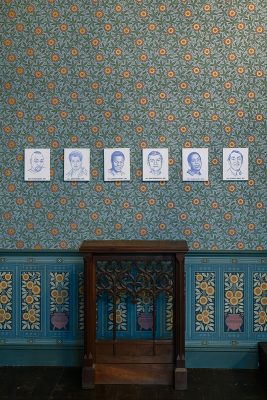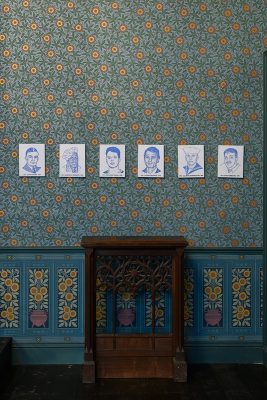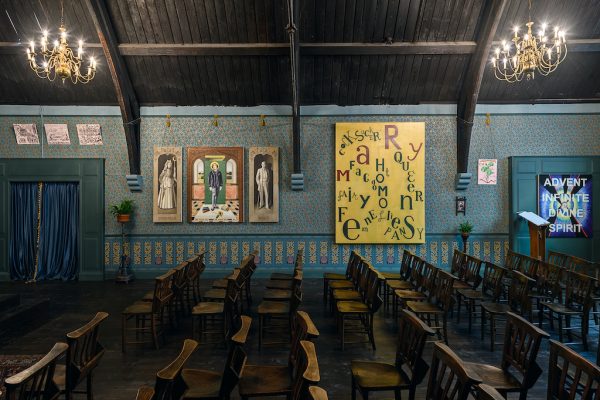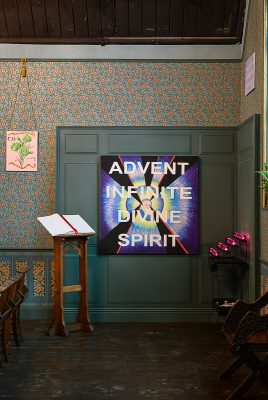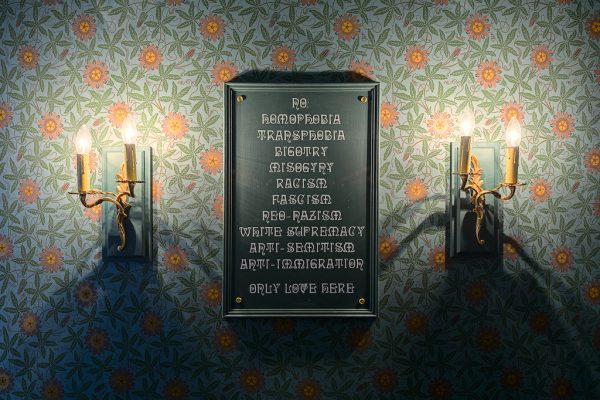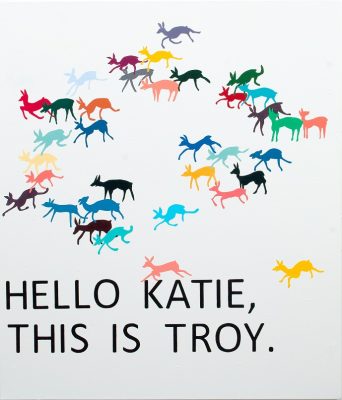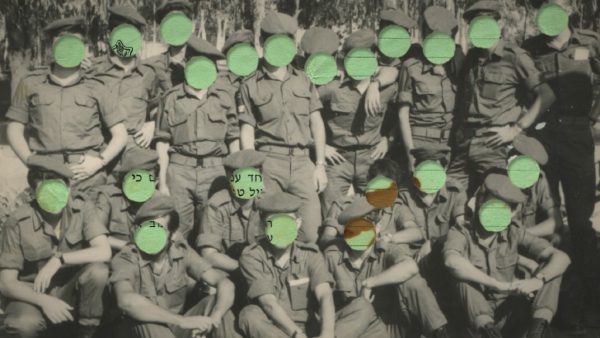The light is dim, the air richly scented. Little purple tea lights flicker in the votive candle rack and the walls are decorated with twining sunflowers, exuberant passionflowers and several canvases of blousy green carnations monogrammed with Oscar Wilde’s prisoner ID number C.3.3. The Temple is a deconsecrated church with an attractive dark wood ceiling and matching antique chairs. A half-size marble statue of Wilde presides. The artists, McDermott and McGough, have painted various icons spelling out pejoratives such as ‘pansy’, ‘faggot’ and ‘cocksucker’, adorned with gold leaf and richly-coloured paint. Towards the back are intricate woodcut-style depictions of massacres with titles like ‘Nun Cutting Rope of Dead Homeric’, black canvases with cut-out fatality statistics, and monochrome portraits of individuals more recently killed by homophobia and transphobia, such as Justin Fashanu, Brandon Teena and Marsha P. Johnson. A placard in the hallway spells out all of the bigotries the temple stands against, ending with the instruction ‘only love here’. Opposite is a purpose-built offertory box ‘For the Sons and Daughters of Oscar Wilde’.
The Temple’s hosts, Studio Voltaire, emphasise its role as a community venue for LGBTQ+ people and their allies. The Temple is open to any members of the public who wish to visit. It is also a venue for LGBTQ+ wedding ceremonies and discussion groups, as well as a mentoring scheme for young people in partnership with the homelessness charity The Albert Kennedy Trust. Wilde’s fame and the high drama of his story – the libel suit he brought against his lover Lord Alfred Douglas’s father for calling him a sodomite, his subsequent prosecution for gross indecency, his miserable years in prison and premature death in exile in France – are instrumentalised by McDermott and McGough as something for everyone to rally around. The Temple was first installed in New York, in the Russell Chapel of the Church of the Village. The idea for it to travel to London developed in tandem with a campaign to erect a nearby rainbow plaque commemorating Wilde’s traumatic humiliation at Clapham station as he was transferred from Wandsworth Prison to Reading Gaol. Freshly out of hospital, Wilde was exposed to the homophobic jeers of his once-adoring public, while handcuffed and in convict dress.
The Temple, and its current proximity to Clapham station, recontextualise Wilde’s humiliation as part of a martyrdom narrative, elevating him to the status of a saint. Medievalist academic Sarah Salih writes that ‘saints were the superheroes and the celebrities of medieval European culture. Like superheroes, they were ordinary humans who had somehow become extraordinary, using their special powers to help their supporters and to protect the vulnerable’. Through extreme piety, the martyr transcends his base state of humanness and is refined into a symbol. Commemorating Oscar Wilde as a martyr subverts traditional Christian teachings on bodily purity and homosexuality, while pointing out the homoeroticism in many medieval and early modern representations of male martyrs. Yet a lavish excess of adoration for one privileged white cisgender man may not be the best way to draw together a diverse LGBTQ+ audience. Perhaps McDermott and McGough hope that through venerating Wilde, visitors to the Temple will allow themselves to be drawn into contemplation of other lives cut short and recognise a common cause. Even so, the Temple’s twin aims of canonising Wilde and emphasising queer unity continue to sit uncomfortably together, as we are asked both to elevate Wilde’s suffering above other people’s and to identify with him.
The contradiction at the heart of the project can be seen in The Stations of Reading Gaol (2017), a series of twelve ornate, stylised blue and gold paintings of scenes from Wilde’s prosecution and imprisonment that show him with a halo. One of them, IX. The Arrest of Taylor, shows Alfred Taylor, Wilde’s procurer, being seized by two men so he could be tried alongside Wilde. At the four corners of the canvas are small, oval portraits of the young men who testified at Wilde’s trial, one of whom was aged only sixteen to his thirty-eight.
Given that Wilde wrote to his friend and sometime lover, Robbie Ross, of his exploits with boys in Algiers, and the chambermaid at the Savoy who testified against Wilde said the ‘renter’ she saw in his bed looked about fourteen, he does seem to have had a predilection for younger men with much less social standing than himself. Hagiographic accounts of Wilde’s suffering often leave this detail out, because it is inconvenient that one of the first people in Britain to publicly proclaim their queerness and accept the punishment for it should have behaved in a fashion we now find highly questionable. There is an unavoidable irony in the Temple’s fundraising on behalf of a charity that works with young LGBTQ+ people at risk of exploitation.
Making Wilde a saint obscures his humanity and the reality of the suffering he both endured and inflicted. Nobody – not Wilde, or any of those named by the Temple who were subjected to abuse because of their sexuality or gender – should need to be considered good or special in order to live free from bigotry. On the night I visited, two actors conducted a mock-trial of Lord Alfred Douglas on the grounds that he was responsible for causing his death. One side put a convincing case that Douglas was a deeply unpleasant and exploitative person, but the side which won most votes used the argument that the society Douglas lived in was more to blame than he was. Just as some modern audiences might be disinclined to single Wilde out for sainthood, there was a corresponding lack of enthusiasm to cast Douglas out as a devil.
What Wilde’s troubling legacy makes most visible is the way that queer history is not a lineage but associated fragments. The Temple’s failure as a piece of high camp reputation-laundering is what makes it interesting – Studio Voltaire has become a site where different ideals of personal freedom can converge and contest one another, but can’t be made to line up neatly as if they are the same. Love is not the only thing to see here, thank the saints.
